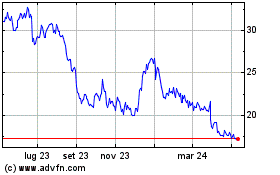Walgreens Tests Digital Cooler Doors With Cameras to Target You With Ads
11 Gennaio 2019 - 12:59PM
Dow Jones News
By Lara O'Reilly
Walgreens Boots Alliance Inc. is testing a technology that
embeds cameras, sensors and digital screens in the cooler doors in
its stores, a new network of "smart" displays that marketers can
use to target ads for specific types of shoppers.
The refrigerator and freezer doors act as a digital
merchandising platform that depicts the food and drinks inside in
their best light, but also as an in-store billboard that can serve
ads to consumers who approach, based on variables such as the
approximate age the technology believes they are, their gender and
the weather.
This new technology could provide brick-and-mortar stores with a
marketplace similar to online advertising. Ice cream brands could
duke it out to get the most prominent placement when it is 97
degrees outside; an older man could see ads for different products
than a younger woman.
Cameras and sensors inside the coolers connected to
face-detection technology also can determine which items shoppers
picked up or looked at, giving advertisers insight into whether
their on-screen promotions worked -- and can let a retailer know
quickly if a product has gone out of stock.
The system is provided by Chicago-based Cooler Screens Inc., the
brainchild of Arsen Avakian, the startup's co-founder and chief
executive and the former CEO of Argo Tea Inc. The idea was born in
part out of his frustration spending hours in store cooler aisles
trying to figure out how to promote Argo's bottled ice teas, he
said.
Cooler Screens' other co-founders include former Walgreens Boots
Alliance Chief Executive Gregory Wasson; Glen Tullman, executive
chairman of health technology company Livongo Health Inc.; and
Jamie Koval, former president of brand and marketing agency VSA
Partners Inc.
Founded in 2017, the company has raised around $10 million in
funding. Its most recent round of financing was led by Microsoft
Corp., which is offering software to power the Cooler Screens
technology and infrastructure.
Around 15 large advertisers have signed up to test the Cooler
Screens platform, including Nestlé SA, MillerCoors LLC and Conagra
Brands Inc.
A big barrier for MillerCoors is that half of shoppers aren't
aware beer is available in drugstores, said Brooke Roller, senior
marketing manager of the small format channel for MillerCoors, in a
statement. The Cooler Screens technology "gives us the ability to
dynamically influence the shopper at the point of purchase and get
them to add beer to the basket, " she said.
Cooler Screens is hoping to tap into ad budgets that are
traditionally spent outside of stores, primarily in television and
digital, rather than just scrapping over so-called trade marketing
spending that helps get products on shelves in desirable locations
and with the best promotion.
Morgan Stanley analysts estimated in a January 2018 research
note that trade marketing spending in the U.S. reached $178 billion
in 2017. Media-buying agency GroupM estimated U.S. media
advertising investment, a figure that doesn't include trade
marketing spending, was $188 billion in 2017.
Ad revenue will be split between participating retailers and
Cooler Screens on a sliding scale, with each side's take ranging
from around 25% to 75%, Mr. Avakian said.
Walgreens began testing Cooler Screens in a Chicago store in
November and plans to extend the pilot to five more stores in San
Francisco, and to Manhattan and Seattle by the end of January,
according to Walgreens. Cooler Screens also is looking to expand
beyond Walgreens.
Brands have had some opportunities to use sensors and cameras in
and outside of stores for advertising before. Last November, in one
example, the Movember Foundation men's health charity ran a digital
billboard campaign in Australia and the U.K. that served different
messages to passersby, depending on whether or not they had facial
hair.
Still, the idea of being targeted in-store with digital ads is
unfamiliar to most consumers. Its success depends on balancing
"what's appropriate targeting and what's potentially on the edge of
being a bit intrusive," said Jane Ostler, global head of media at
the insights division of WPP PLC research company Kantar.
Mr. Avakian said a survey during the Chicago pilot found
consumers strongly preferred the digital doors to standard ones and
thought they made the products inside seem more appealing.
"The business model is not built on selling consumer data," said
Mr. Avakian. "The business model is built on providing intelligence
to brands and to the retailers to craft a much better shopping
experience."
The company says it only produces and stores anonymous metadata
that describes the size and demographics of an audience, and
doesn't store or transmit image data or unique identifying
information about shoppers. Walgreens also is posting a privacy
statement and a concierge to answer customer questions near the
coolers in its stores that test them, a Walgreens spokesman
said.
Write to Lara O'Reilly at lara.oreilly@wsj.com
(END) Dow Jones Newswires
January 11, 2019 06:44 ET (11:44 GMT)
Copyright (c) 2019 Dow Jones & Company, Inc.
Grafico Azioni Walgreens Boots Alliance (NASDAQ:WBA)
Storico
Da Mar 2024 a Apr 2024

Grafico Azioni Walgreens Boots Alliance (NASDAQ:WBA)
Storico
Da Apr 2023 a Apr 2024
